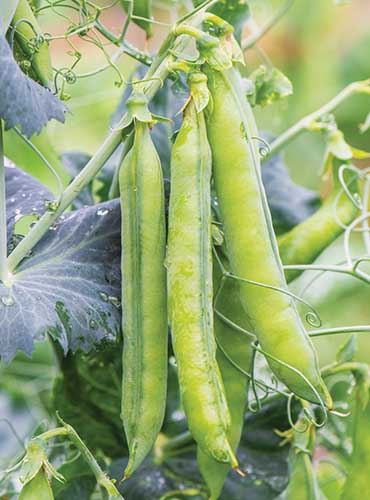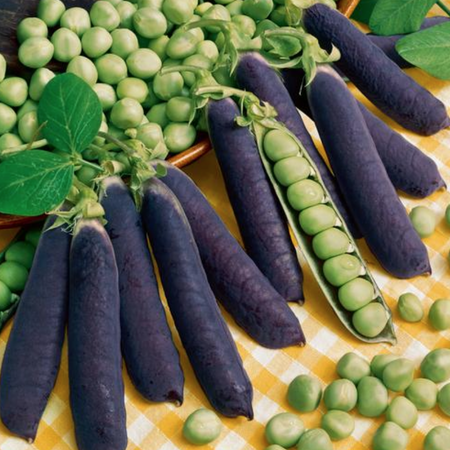PEAS
GENERAL INFORMATION
It belongs to Leguminaceae family. It is a cool season crop grown throughout the world. Green pods are used for vegetable purpose and dried peas are used as pulse. In India it is cultivated in Himachal Pradesh, Madhya Pradesh, Rajasthan, Maharashtra, Punjab, Haryana, Karnataka and Bihar. It is rich source of proteins, amino acids and sugars. Green peas straw is good source of nutritional fodder for livestock.
temprature
15°C - 30°CSowing Temperature
20°C - 30°CHarvesting Temperature
15°C - 20°CRainfall
400-500 mmSOIL
It can grow on various soil types from sandy loam to clay soils. It gives best results when grown under well drained soil with pH range of 6 to 7.5. Crop cannot withstand in water logging conditions. For acidic soil, do limming.POPULAR VARIETIES WITH THEIR YIELD
PG 3
Locally known as Sikkim. It is commercially grown in the states of Assam and Meghalaya. Medium to large sized trees, dense foliage with thorns. Orange-yellow to bright orange color fruits with smooth surface. Orange color fruits with 9-25 seeds.Punjab 88
It is a hybrid variety between King and Willow leaf. Plants are large sized, symmetrical with dense foliage, broad leaves. Fruits are medium in size, deep orange yellow colored on ripening, and adherent juicy fruit with 12-24 seeds. Fruit matures in the months of January-February. This variety when first introduced into Punjab performed very well and gained high commercial significance..Matar Ageta 6
Trees are up righted, vigorous having compact foliage. Fruits are bright orange in color, medium to large size, easily peeled with 9-11 segments. The variety contains abundant juice with 15-25 seeds. The variety matures in February-March months.Field Pea 48
Trees are up righted, vigorous having compact foliage. Fruits are bright orange in color, medium to large size, easily peeled with 9-11 segments. The variety contains abundant juice with 15-25 seeds. The variety matures in February-March months.AP 3
It is an early maturing variety. IT is ready for first harvesting after 70 days of sowing, if it sown in second week of October. It gives an average yield of 31.5qtl/acre.Matar Ageta-7
It is an early variety which is ready for harvesting in 65-70 days. It gives an average yield of 32qtl/acre.Punjab 89
legumes bear in couple. The variety is ready for first harvesting after 90 days of sowing. The seeds are sweet in taste and the legumes give 55% seeds. It gives an average yield of 60qtl/acre.Mithi Fali
First harvesting is done after 90 days of sowing. The variety is rich with protein and sweetness. It gives an average yield of 47qtl/acre.

|
|

|
EARLY SEASON VARITIES
- Asauji Developed at IARI.
- Early Superb Dwarf variety from England.
- Arkel Variety from France. Gives yield of 16-18qtl/acre.
- Little Marvel Dwarf variety from England
- Alaska
- Jawahar Matar 3 ives average yield of 16qtl/acre
- Jawahar Matar 4 Gives average yield of 28qtl/acre.
- Pant Matar
MID-SEASON VARITIES
- Bonneville Variety from USA. Gives average yield of 36qtl/acre.
- Alderman Perfection New line, T 19
- Lincon Gives average yield of 40qtl/acre.
- Jawahar Matar 1 Gives average yield of 48qtl/acre
- Jawahar Matar 2
- Pant Uphar Gives average yield of 40qtl/acre.
- Ooty 1 Gives average yield of 48qtl/acre.
- Jawahar Pea 83 Gives average pod yield of 48-52qtl/acre
- Jawahar Peas 15 Gives average pod yield of 52qtl/acre.
SOWING
Time of sowing
To obtain good yield complete sowing between October end to Middle of November. Further delay in sowing will lead to yield loss. For early market, some growers sow peas in second fortnight of October..
Spacing
Use spacing of 30cmx5cm for early varieties and for late varieties use spacing of 45-60cm x 10cm.Sowing Depth
Sow the seeds at depth of 2-3cm in soil.Method of sowing
For sowing use seed cum fertilizer drill on ridges which are 60 cm wide.SEEDS
Speed rate
For sowing in one acre land use seed rate of 35-40kg/acre.Seed treatment
Before sowing, treat the seed with Captan or Thiram@3gm/kg of seed or Carbendazim@2.5gm/kg of seed. After chemical treatment, treat seeds with Rhizobium leguminosorum culture for better quality and yield. The culture material is emulsified in 10 percent sugar solution or jaggery solution. Mix thoroughly the emulsified culture with seed and dry in shade. It will increase yield upto 8-10%. Use any one of fungicides Fungicide name Quantity (Dosage per kg seed) Captan 3gm Thiram 3gm Carbendazim 2.5gmFERTILIZER
Fertilizer Requirement (kg/acre) UREA SSP MURIATE OF POTASH 45 155 On soil test results
Nutrient Requirement (kg/acre) NITROGEN PHOSPHORUS POTASH 20 25 #
At time of sowing apply Nitrogen@20kg in form of Urea@50kg and Phosphorus@25kg in form of Superphosphate@150kg per acre. Drill complete dose of fertilizer along the rows.